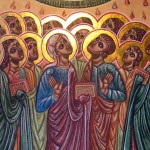Almighty God, by the hand of Mark the evangelist you have given to your Church the Gospel of Jesus Christ the Son of God: We thank you for this witness, and pray that we may be firmly grounded in its truth; through Jesus Christ our Lord, who lives and reigns with you and the Holy Spirit, one God, for ever and ever. Amen.
Collect for the Feast of St. Mark, the Evangelist
Today we join the church in celebrating St. Mark, the Evangelist on his feast day. As Joel Green writes, “We know next to nothing about this Mark except what we can glean from the gospel itself.”[1] The celebration of Mark’s feast day is therefore a celebration of his gospel account.
As any seminarian, pastor or theologian may tell you: Mark’s gospel is tough. It doesn’t fit into our neat categories of what a gospel should be or what a gospel should contain, and therefore many questions are raised about the text. From the beginning of Mark—literally the first verse of the opening chapter—to the end, there are questions about interpolations, reductions, and more.
I fear that Mark often gets the “short end of the stick” when listed alongside Matthew, Luke and John. Many commentators, opponents and scholars have complained that:
- Mark is the shortest of the four gospels
- It ends abruptly
- It is the least descriptive of the resurrection
- It contains the messianic secret
Martin Kähler even described the gospels generally and Mark specifically as “passion narratives with extended introductions.”[2]
I have actually come to love Mark’s gospel. Reading Mark requires that we celebrate tension, embrace mystery and discipleship, and look for the breaking in of God’s kingdom.
Celebrate Tension
Mark ends abruptly, particularly when you take in to account that the last 11 verses of the gospel do not appear in all of the earliest manuscripts. The “shorter” version ends in Mark 16:8 with Mary and the women fleeing the empty tomb in fear and amazement. There is no record of the resurrected Jesus in this story; after spending 15 chapters describing Jesus’ ministry and death the ending is simple: the tomb was empty.
Some of the earliest manuscripts include verses 9-20 that depict Jesus appearing to Mary and then to the two disciples, commissioning the eleven, and finally his ascension. We would know all of this from reading the other evangelists as well, but the addition of these eleven verses makes for a cleaner, more satisfactory ending.
But what if the story really ended in verse 8?
N.T. Wright suggests, “No history, no biography, ever tells you everything. All history selects and arranges, not to falsify but to highlight what is significant.”[3]Each of the four gospels can and should be read alone as individual accounts but they should also be read parallel to one another. Mark’s gospel is not exhaustive, nor is Matthew, Mark or Luke. Each biography (gospel) provides a unique vantage point focused on one topic: the person, life, death and resurrection of Jesus. The four gospels collectively form a biographical symphony providing glorious melody, harmony, and major and minor notes describing Jesus of Nazareth.
Therefore, we need to celebrate the tension that comes from not having all of our questions answered. The Gospel of Mark is no less inspired or holy depending on the inclusion of Mark 16:9-20, it still tells the story of Jesus’ ministry, his death, and proclaims that he has been raised. Fear does not have the last word in the short version; the Good News of the Risen One is still shared! Mark’s gospel was the earliest account of Jesus written and was likely used by Matthew and Luke—and perhaps John—in the composition of their own biographies. It was considered to be the most trustworthy based on its early date and we should trust it still even if all of the loose ends aren’t tied up into a nice bow.
Embrace Mystery and Discipleship
Mark’s gospel is well known for containing the messianic secret—the idea that the disciples (and others) did not and could not know that Jesus was the Messiah until after his death. In Mark 5:43 and 7:36 we find Jesus commanding people to not tell others who he is after he had healed them. But why? Why would Jesus want his identity kept a secret? And why would Mark be the only gospel writer to hone in on this? The twelve followed their leader for several years without really knowing who he was. And that’s the point! How could they have possibly understood Jesus’ true identity on that side of the cross and empty tomb?
The reader is given a real and raw look at Jesus of Nazareth in Mark’s Gospel. Jesus healed many and died at the hands of the Roman government, his tomb was empty, but it is left up to the reader as to whether or not they will follow this man. The picture of discipleship in Mark’s Gospel is not one of comfort or ease. Mark paints the picture of discipleship and cross joined together. “Mark’s narrative braids together these two strands, Christology and discipleship, in order to show that one flows into the other.”[4] Jesus predicts his death in Mark 8:31-32 and then insists that his followers will face consequences for their decision to be his disciples, they will have to: deny themselves, take up their cross, follow him, and lose their lives to save them.
Jesus can and should be understood in the context of Israel’s story. “Mark weaves a narrative, and in doing so evidences his conviction that only a ‘storied christology’ will do, that our capacity to grasp the significance of Jesus in a way that can be transformative is dependent upon the story of Jesus, and the embeddedness of Jesus in the story of God.”[5] Mark brings together the Old Testament image of “Son of Man” found in Daniel 7 and that of Messiah in Isaiah. This combination of Old Testament images was not what the disciples or the religious elite of the day had in mind when referring to the Messiah; the disciples still followed Jesus without fully understanding who he was before his death. The mystery of Christ is one for us to embrace as his disciples.
God’s World Breaks In[6]
From the beginning of the gospel the reader is sure of one thing: in and through Jesus the Kingdom of God is breaking into this world. Jesus began his ministry by announcing publically that the “The time is fulfilled, and the kingdom of God has come near; repent, and believe in the good news.” The urgency in Mark’s language is fulfilled and realized in the drama of his reality: God is up to something and it is important. Wright comments, “The four gospels present themselves as the climax of the story of Israel.”[7]
Now, God is not activating Plan B in Mark’s gospel—or in any of the gospels for that matter. “This new thing that God is doing is the new thing he had always promised.”[8] Mark fills his story with references to Jewish texts, to the ancient Scriptures of Israel, as a means of pointing out that God is fulfilling Israel’s story in the person of Jesus.
The in-breaking of God’s kingdom therefore looks like Jesus’ ministry: healing, deliverance, repentance, conversion, discipleship and life through death. Jesus is the fulfillment of Israel’s prophesies that one day God will be King, one day he will come to set the captives free and bring sight to the blind, one day God’s people will feast with him at a great banquet table, and one day there will be no more pain, or tears or death. And Jesus announces that the time has been fulfilled! God is doing exactly what he promised even if it looks different than expected.
Commemoration
Today we celebrate and commemorate Mark on account of his gospel. We should remember Mark’s desire to present Jesus as fully man in an authentic and powerful way and celebrate the tension of not having all the answers. We need to embrace the mystery of Christ and the call to discipleship as depicted in his gospel. Perhaps then we can encounter the Crucified Lord through Mark’s storytelling with the assured knowledge that he is Risen and his kingdom is in-breaking.
[1] Stephen C. Barton, ed., The Cambridge Companion to the Gospels, Cambridge Companions to Religion (Cambridge, UK: Cambridge University Press, 2006), Joel Green, “The Gospel according to Mark”, 143.
[2] Ibid, 139.
[3] N T. Wright, How God Became King: The Forgotten Story of the Gospels (New York: HarperOne, 2012), 63.
[4] Green, 152.
[5] Green, 148.
[6] Wright, 74.
[7] Ibid, 65.
[8] Wright, 75.











